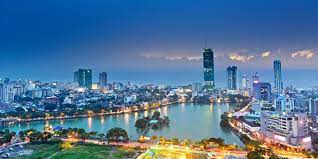The world is a busy place, with politics changing and events happening all the time. However, we make it simple to quickly read all the pertinent data for every country, in addition to flag details and an atlas summary for what kind of general information you are most interested in.
The following basic facts and information are covered in detail in each Country’s Profile:
Maps, geography, Brief history, the current ruler, area, population, capital, and largest cities – Languages-Race and ethnicity – Faith – Rate of literacy and The economy.
Facts & Information about Sri Lanka
LetsExplore has everything you need to know about Sri Lanka. Check out our country profile, full of essential information about Sri Lanka’s geography, history, government, economy, population, culture, religion, and languages.
Flag Of Sri Lanka

Map of Sri Lanka

President: Ranil Wickremesinghe (2022)
Prime Minister: Dinesh Gunawardena (2022)
Land area: 24,996 sq mi (64,740 sq km); total area: 25,332 sq mi (65,610 sq km)
Population (2014 est.): 21,866,445 (growth rate: 0.86%); birth rate: 16.24/1000; infant mortality rate: 9.47/1000; life expectancy: 76.35; density per sq mi: 836.6
Capital and largest city (2011 est.): Colombo, 693,000.
Legislative and judicial capital: Sri Jayawardenepura Kotte, 126,000
Other large cities: Dehiwala-Mount Lavinia 245,974; Moratuwa, 207,755; Negombo, 127,754
Currency: Sri Lanka rupee
Languages: Sinhala 74% (official and national), Tamil 18% (national), other 8%; English is commonly used in government and spoken competently by about 10%
Ethnicity/race: Sinhalese 73.8%, Sri Lankan Moors 7.2%, Indian Tamil 4.6%, Sri Lankan Tamil 3.9%, other 0.5%, unspecified 10% (2001)
Religions: Buddhist 69.1%, Islam 7.6%, Hindu 7.1%, Christian 6.2%, unspecified 10% (2001)
Literacy rate: 91.2% (2010 est.)
Economic summary:
GDP/PPP (2013 est.): $134.5 billion; per capita $6,500.
Real growth rate: 6.3%.
Inflation: 4.7%.
Unemployment: 5.1%
.
Arable land: 18.29%.
Agriculture: rice, sugarcane, grains, pulses, oilseed, spices, vegetables, fruit, tea, rubber, coconuts; milk, eggs, hides, beef; fish.
Labor force: 8.528 million (2013 est.); services 42.4%, agriculture 31.8%, industry 25.8% (2012 est.).
Industries: the processing of agricultural products such as rubber, tea, coconuts, tobacco, and others; banking, insurance, telecommunications; travel, shipping; apparel, textiles; cement, petroleum refining, information technology services; and construction. Natural resources: limestone, graphite, mineral sands, gems, phosphates, clay, hydropower.
Exports: $10.39 billion (2013 est.): textiles and apparel, tea and spices; rubber manufactures; precious stones; coconut products, fish.
Imports: $18 billion (2013 est.): petroleum, textiles, machinery and transportation equipment, building materials, mineral products, foodstuffs.
Major trading partners: U.S., UK, India, Germany, Singapore, UAE, China, Iran, Malaysia, Italy, Belgium (2012).
Communications:
Telephones: main lines in use: 2.796 million (2013); mobile cellular: 19.533 million (2013). Radio broadcast stations: 50 (2012). Radios: 3.85 million (1997). Television broadcast stations: 35 (2012). Televisions: 1.53 million (1997). Internet Service Providers (ISPs): 9,552 (2012). Internet users: 1.777 million (2009).
Transportation: Railways: total: 1,449 km (2007). Highways: total: 114,093 km; paved: 16,977 km; unpaved: 97,116 km (2010). Waterways: 160 km; navigable by shallow-draft craft (2012). Ports and harbors: Colombo, Galle, Jaffna, Trincomalee. Airports: 19 (2013).
Member of the Commonwealth of Nations
Geography
About half the size of Alabama, Sri Lanka is an island in the Indian Ocean off the southeast coast of India. In the south-central region, mountains climb to above 8,000 feet (2,438 meters), but the majority of the land is low and rolling.
Government Type: Republic.
History
The main ethnic group in Sri Lanka today, the Sinhalese, are descended from Indo-Aryan emigrants who left India in the fifth century B.C. The second-largest ethnic group on the island, the Tamils, originally came from the Tamil area of India and left between the third and the eleventh centuries of the common era. Sinhalese and Tamil kings fought for sovereignty of the island until colonial powers took control of Ceylon, the name given to the nation until 1972. The Sinhalese, who are mainly Buddhists, ruled the south of the island, while the Tamils, who are mostly Hindus, claimed the north. Ceylon was occupied by the Portuguese in 1505, but the Dutch India Company eventually usurped power (1658–1796).
After the British acquired control in 1796, Ceylon became a province of the English Crown in 1802. Rubber, tea, and coffee plantations were created by the British. Following pressure from nationalist leaders in Ceylon, who for a short while brought the Tamil and Sinhala people together, Ceylon became a self-governing dominion of the Commonwealth of Nations on February 4, 1948.
When S.W.R.D. Bandaranaike took office as prime minister in 1956, he promoted Sinhalese nationalism and further marginalized the Tamil minority by declaring Sinhala to be the only official language of the nation and providing official support for Buddhism. It was a Buddhist monk who killed him in 1959. In 1960, Sirimavo Bandaranaike, his widow, was elected as the first female prime minister in history. On May 22, 1972, the name Ceylon was replaced with Sri Lanka, which means “resplendent island.”
Bloody violence broke out in 1983 as a result of the Tamil minority’s growing dissatisfaction of the Sinhalese majority’s monopoly on political and economic power, which was further aggravated by cultural and religious divides. To fight for their own homeland, Tamil rebel organizations, the most powerful of which was the Liberation Tigers of Tamil Eelam, or Tamil Tigers, started a civil war.
A Tamil rebel detonated explosives strapped to his person during a May Day political gathering in 1993, killing President Ranasinghe Premadasa. Attacks by terrorists targeting people have been a common tactic used by Tamil extremists. Chandrika Kumaratunga, the incoming president, pledged to bring peace back to the nation. She sustained injuries in a terrorist strike in December 1999. More than 64,000 people have died in 18 years of war, the majority of them civilians, by the beginning of 2000.

Leave a Reply